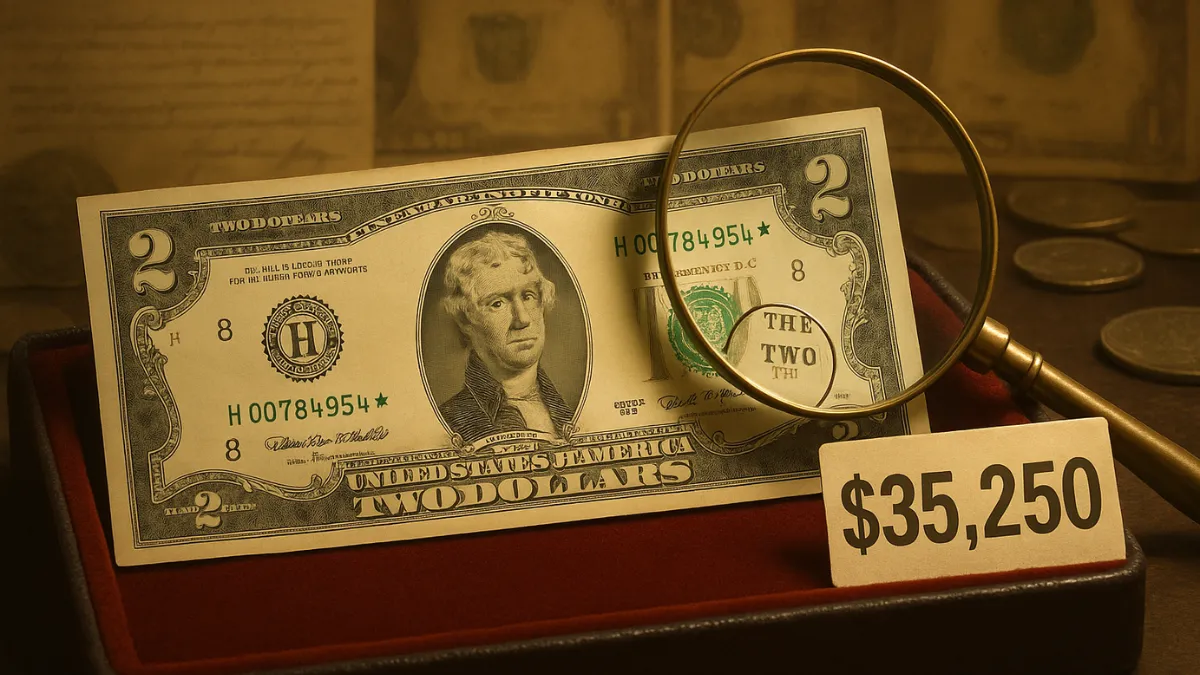The United States wasn’t always the country we know today. It officially gained independence on July 4, 1776, with the signing of the Declaration of Independence. Since then, the nation has experienced wars, economic challenges, and political changes that have shaped both its character and place in the world.
Each year, Americans celebrate the Fourth of July with fireworks, parades, and patriotism. But the 1976 celebration was particularly meaningful—it marked 200 years of independence. To recognize this historical moment, the U.S. Mint introduced a special edition $2 bill.
What’s Unique About the 1976 $2 Bill?
The front side of the 1976 $2 note continues to feature Thomas Jefferson, as seen on earlier versions. However, the back is where the design truly stands out. It includes a detailed print of John Trumbull’s iconic artwork, “The Declaration of Independence,” which shows the presentation of the document to the Continental Congress.
Here’s an interesting tidbit: these notes are relatively uncommon today because they weren’t widely circulated when they were introduced. During that time, the U.S. economy was in a downturn, and most people weren’t inclined to hold onto a $2 bill—it was seen as too much to keep unused. Think of it like walking around with a $1,000 bill now—it just wouldn’t be practical.
A Bit of Background on the 1976 Series
In the early 1970s, Congress approved the idea of reviving the $2 denomination, and the updated bill was officially launched on July 5, 1976. Although the series date reads 1976, no additional bills of this version were printed until 1995. As a result, many of these notes remain in excellent condition since they were never actively used.
Because they weren’t part of everyday transactions, a large number stayed crisp and unfolded. Their historical context and unique design have helped make them a favorite among collectors and currency enthusiasts.
How to Tell If a 1976 $2 Bill Is Valuable
If you’ve got a 1976 $2 bill and are curious whether it might be worth more than just two dollars, here are some features that could raise its value:
Condition (Grade): The better the shape, the more a bill is worth. Notes with no creases, tears, or stains fetch higher prices.
Serial Number: Collectors value unusual serial numbers—like those with repeated digits or very low numbers.
Signatures: Bills signed by Arthur Burns and Robert B. Anderson (among the last to sign that series) are often worth more.
Federal Reserve District: The U.S. is divided into 12 Federal Reserve Banks, and some printed fewer $2 bills than others. Notes from these districts may be rarer.
Star Notes: Look for a star symbol at the end of the serial number—these were used to replace misprinted bills and are scarcer.
Post Office Stamps: Some post offices marked these bills on their release date. Stamped versions are considered collectible items.
How Much Is a 1976 $2 Bill Worth?
The worth of a 1976 $2 bill can vary based on its rarity, physical condition, and features that interest collectors. Here’s a look at different pricing tiers:
Low-Priced Bills (Under $20)
These are mostly circulated notes with visible signs of use—folds, dirt, or other marks. They’re good for those starting out in currency collecting.
Example: A very worn 1976 $2 bill may be valued at about $5.
An uncirculated note from the Dallas Federal Reserve (“K” series) could sell for close to $9.90.
A pristine Kansas City (“J” series) note in crisp condition might bring in around $16.50.
Mid-Range Bills ($20–$500)
These tend to be in excellent condition or have unique qualities like being star notes or having special stamps.
Example: A New York star note might command a price of $95.
A high-grade bill featuring a post office stamp from the release date might be valued around $399.
An autographed Kansas City star note could be priced at $257.
High-End Bills ($500–$2,500)
These are exceptionally well-preserved notes or have rare attributes like low serial numbers or professional grading.
Example: A mint-condition bill with both an autograph and star designation might be worth $850.
A note with a very low serial number, such as 33, might sell for close to $2,000.
A pair of consecutive serial numbers could be listed for over $2,000.
Top-Tier Collectibles ($2,500 and up)
These bills are incredibly rare and are typically in mint condition, often still in their original packaging or with unique identifiers.
Example: A full bundle of 100 uncirculated bills can go for as much as $3,450.
A note with serial number “00000002” reportedly sold for $9,400.
A San Francisco-issued note bearing serial number “00000001” was once purchased for over $21,000.
The only privately held star note with a serial number of 1 was sold for $35,250.
FAQs About 1976 $2 Bills
How can I tell if mine is a star note?
Check the end of the serial number. If there’s a star symbol instead of a letter, it’s a star note.
Are there any printing errors to watch for?
Yes—errors like misaligned prints, missing design elements, or serial number mismatches can make a bill much more valuable.
How do I know if my bill is real?
You can check for several security features—though basic back then—including correct serial format, authentic paper texture, and clear, sharp printing.
Final Thoughts
The 1976 $2 bill isn’t just money—it’s a commemorative artifact. Whether you’re diving into the world of collecting or already have experience, owning one of these notes offers a tangible connection to America’s 200th birthday.
You don’t need a big budget to start collecting; even lower-cost examples can be fun to own. And if you’re ready to invest, rare notes can be standout additions to any collection. Just make sure to educate yourself, watch out for counterfeits, and enjoy the excitement of the hunt.
Happy collecting!
